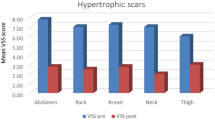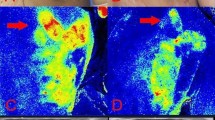Abstract
Treatment of keloids (K) and hypertrophic scars (HTS) is challenging. A few case reports reported good results in HTS treated by fractional CO2 laser. The aim of the present study was the assessment of the clinical response as well as histological changes in K and HTS treated by fractional CO2 laser and the role of matrix metalloproteinase 9 (MMP9) in the response. A randomized half of the scar was treated by fractional CO2 laser in 30 patients (18 K, 12 HTS) for a total of four sessions 6 weeks apart. Vancouver scar score (VSS) was done before and 1, 3, and 6 months after the last laser session by a blinded observer. Biopsies taken from normal skin, untreated scar, and treated scar tissue 1 and 3 months after the laser sessions were stained by HX & E for histological changes and Masson trichrome for collagen fiber arrangement. Immunohistochemical staining for MMP9 was done in before and 1 month after samples. Quantitative morphometric analysis was done for collagen and MMP9 by image analyzer. Nineteen patients completed the 6-month follow-up period (12 K, 7 HTS). VSS score was significantly lower in the treated compared to untreated areas after 3 and 6 months in both K and HTS but was mainly due to improved pliability of the scar. Histologically, dense inflammatory infiltrate and increased vascularity was apparent 1 month after laser sessions and disappeared at 3 months. Thinner better organized collagen bundle could be seen in 3 months after samples. MMP9 was significantly increased in after treatment samples but without significant correlation with VSS. Fractional CO2 resurfacing is safe but affects mainly pliability of K and HTS with collagen remodeling apparent 3 months after therapy. MMP9 may play a role in mechanism of action of CO2 laser in K and HTS.








Similar content being viewed by others
References
Mustoe TA, Cooter RD, Gold MH et al (2002) International clinical recommendations on scar management. Plast Reconstr Surg 110:560–571
Mrowitz U, Seifert O (2009) Keloid scarring: new treatments ahead. Actas Dermosifiliogr 100(supl.2):75–83
Waibel J, Beer K (2008) Fractional laser resurfacing for thermal burns. J Drugs Dermatol 7:59–61
Hædersdal M (2009) Fractional ablative CO2 laser resurfacing improves a thermal burn scar. J Eur Acad Dermatol Venereol 23:1340–1341
Heckmann M, Adelmann-Grill BC, Hein R et al (1993) Biphasic effects of IL1α on dermal fibroblasts enhancement of chemotactic responsiveness at low concentrations and of mRNA expression for collagenase at high concentrations. J Invest Dermatol 100:780–784
Kiernan JA (2008) Histological and histochemical methods: theory and practice, 4th edn. Scion, Bloxham, UK
Kelly BC, Markle LS, Vicker JL et al (2010) The imbalanced expression of matrix metalloproteinases in nephrogenic systemic fibrosis. J Am Acad Dermatol 63:483–489
Niwa ABN, Mello APF, Torezan LA et al (2009) Fractional photothermolysis for the treatment of hypertrophic scars: clinical experience of eight cases. Dermatol Surg 35:773–778
Lee SJ, Kim JH, Lee SE et al (2011) Hypertrophic scarring after burn scar treatment with 10,600-nm carbon dioxide fractional laser. Dermatol Surg 37:1168–1172
Le Pillouer-Prost A, Zerbinati N (2008) Fractional laser skin resurfacing with SmartXide DOT. Initial results. DEKA s.r.l., 1-4
Glaich AS, Goldberg LH, Friedman RH et al (2007) Fractional photothermolysis for the treatment of post-inflammatory erythema resulting from acne vulgaris. Dermatol Surg 33:842–846
Neely AN, Clendening CE, Gardner J et al (1999) Gelatinase activity in keloids and hypertrophic scars. Wound Rep Reg 7:166–171
Reilly MJ, Cohen M, Hokugo A et al (2010) Molecular effects of fractional carbon dioxide laser resurfacing on photodamaged human skin. Arch Facial Plast Surg 12(5):321–325
Author information
Authors and Affiliations
Corresponding author
Ethics declarations
Conflicts of interest
No conflicts of interest are present.
Funding
No funding sources were used to support this work.
Rights and permissions
About this article
Cite this article
Azzam, O.A., Bassiouny, D.A., El-Hawary, M.S. et al. Treatment of hypertrophic scars and keloids by fractional carbon dioxide laser: a clinical, histological, and immunohistochemical study. Lasers Med Sci 31, 9–18 (2016). https://doi.org/10.1007/s10103-015-1824-4
Received:
Accepted:
Published:
Issue Date:
DOI: https://doi.org/10.1007/s10103-015-1824-4




